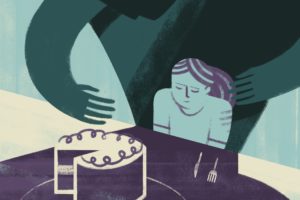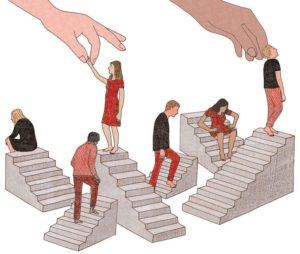Child Sexual Abuse: It’s More about Adults
 On 12th February 2017, around 20 children from across Chennai’s schools came together for a candlelight vigil, in the wake of the shocking rape and murder of 7-year-old in the city[i]. Talking to the media after the protest, Class 6 student Kamakshi A. said, “When I am walking on the road with my mother, I feel nervous. Random men on the street pass comments.”
On 12th February 2017, around 20 children from across Chennai’s schools came together for a candlelight vigil, in the wake of the shocking rape and murder of 7-year-old in the city[i]. Talking to the media after the protest, Class 6 student Kamakshi A. said, “When I am walking on the road with my mother, I feel nervous. Random men on the street pass comments.”
It is not every day that schoolchildren hold press conferences and demand justice. The incident only points to the nightmarish numbers thrown up when one looks into child sexual abuse. India has the world’s largest number of sexually abused children. A child below 16 years is raped every 155th minute, a child below 10 every 13th hour and one in every 10 children sexually abused at any point of time[ii]. In India, 53% of sexually abused children are boys, and 47% were girls.
Who are these abusers? It is easy to imagine a dark alley and a random criminal pouncing upon innocent children, but reality couldn’t be more different. A 14-year old boy in Jaipur was sexually abused for 3 years by his private tutor at the perpetrator’s home[iii]. In Tamil Nadu’s Thiruvallur district, a 14-year-old girl was continuously abused by her father, resulting in the girl being pregnant[iv]. In most cases of the reported cases, the perpetrator of sexual abuse is a relative, family member, friend, or someone known and trusted by the child.
According to the National Crime Records Bureau (NCRB) data for 2015, 94.8% cases of rape registered under the Protection of Children from Sexual Offences (POCSO) Act 2012, the perpetrator was known to the victim[v]. Other sources reveal that family members account for 34.2% of all perpetrators, and acquaintances account for 58.7%. Only 7% of perpetrators are strangers to their victim[vi].
It is impossible to brand or stereotype the typical perpetrator. Their profiles cut across class, vocation, social status and age. Media reported in 2016 that a doctor in Bihar raped a teenage girl after her parents failed to pay for her treatment[vii]. An MLA from Meghalaya was arrested for trafficking and sexual abuse of a 14-year old girl in January 2017[viii]. It was in February 2017 that an Event Manager in Bengaluru was arrested for the rape and blackmail of a 17-year-old girl[ix]. A shopkeeper in Jaipur was arrested in January 2017 for the rape of a minor girl. In the same month, the Principal of a Kendriya Vidyalaya school in Bengaluru was arrested for sexually abusing girl students[x]. What does this tell us? Men who sexually abuse children are often ordinary, respectable men holding positions of responsibility in the family, society, work place and fulfilling their duties as per the demand of their role.
The universality applies to the victims as well. All children, irrespective of their appearance, colour, family background, sexual knowledge are vulnerable to abuse. The most common reason behind abuse is the power imbalance between the perpetrator and the victim. This leaves the child at the mercy of the more powerful abuser, where beauty or sexual precociousness of the child, or its lack thereof, is not a deciding factor in the context of vulnerability. From international level Taekwondo players to mentally challenged girls, sexual abuse cuts across all strata. The range of crimes also varies – according to NCRB, the 14,913 cases reported under POCSO in 2015 include cases of rape, sexual assault, sexual harassment and child pornography.
While the reported numbers are indeed alarming, one should not be fooled to believe that these numbers tell the full story – these form only the tip of the iceberg. Most children do not report abuse to anyone – as per data from the Ministry of Women and Child Development. This could be due to several reasons: they are afraid no one will believe them, they are afraid that the abuser may harm or kill them or their loved ones, they are afraid they will lose the love of their parents and near and dear ones, they do not have a language to disclose abuse. Also, children are unable to take informed, mature decisions when it comes to sex – which means that the perpetrators are manipulating the ignorance, helplessness and fear of these children. Nearly all victims will experience confusion, shame, guilt, anger, and suffer from possessing a poor self- image. Child sexual abuse can result in long-term relationship problems as well.
 According to research, the long-term emotional and psychological damage of sexual abuse can be devastating[xi]. Government data says that 50% of the abusers are persons known to the child or in a position of trust and responsibility – which means that the children suffer from severe trust issues following the trauma. There have been numerous instances of sexual abuse, where children have been blackmailed for years, either using threat of physical violence or sharing of images/information on abuse.
According to research, the long-term emotional and psychological damage of sexual abuse can be devastating[xi]. Government data says that 50% of the abusers are persons known to the child or in a position of trust and responsibility – which means that the children suffer from severe trust issues following the trauma. There have been numerous instances of sexual abuse, where children have been blackmailed for years, either using threat of physical violence or sharing of images/information on abuse.
Many cases go unreported also because children are experts at hiding their pain. Unless the incident was forcefully violent, it is difficult to say from external appearance if the child was sexually abused. A traumatic experience in a child’s life is often expressed through indirect means. Also many children may not show any change in their behaviour or other patterns until much later. In many cases, pregnancy, bleeding and visible physical injuries to private parts have been the primary indicators to ascertain sexual abuse. It needs to be noted that in the absence of an adult witness to the crime and a distinct physical injury on the victim, it is very unlikely that the incidence of abuse will see the light of day.
It is beyond doubt that the issue needs to be tackled at a war footing. However, the question of accountability looms large in any discussion aimed at addressing child sexual abuse. India boasts of the landmark POCSO Act – an extremely powerful legislation which provides unprecedented legal protection for children from sexual abuse. The most critical requirement would be a comprehensive implementation of the POCSO Act, which calls for a concerted effort from the ministries of Women and Child Development, Home Affairs and Human Resource Development. However, little has been done apart from POCSO, in terms of prevention and redressal.
Equally significant is the fact that to bring down the number of incidents, it takes the entire universe of the child to join hands – the family, school, neighbourhood, and the civil society at large. Such a synergetic effort would, as the POCSO Act says, ensure the best interest and wellbeing of the child, regarded as “being of paramount importance at every stage, to ensure the healthy physical, emotional, intellectual and social development of the child[xii].” Though reliable mechanisms for reporting, like the POCSO e-box and 1098 (telephone) exist, the onus is on every adult around chidlren to ensure safety from sexual crimes. Trusting our children, breaking down gender stereotypes, providing honest and open spaces to discuss sex and sexuality, and facilitating age-appropriate sex education will indeed take us a long way forward.
(Author: Bestin Samuel, Researcher, World Vision India)
Ref:-
[i]http://timesofindia.indiatimes.com/city/chennai/sexual-assaults-kids-hold-candlelight-vigil/articleshow/57116417.cms
[ii]Study on Child Abuse: INDIA 2007, Ministry of WCD, Govt of India
[iii]http://timesofindia.indiatimes.com/city/jaipur/minor-abused-by-tutor-case-filed/articleshow/57028693.cms
[iv]http://www.newindianexpress.com/states/tamil-nadu/2017/jan/20/monster-dad-in-tiruvallur-impregnates-minor-daughter-arrested-1561442.html
[v]Crime in India 2015: http://ncrb.gov.in/
[vi]Rape, Abuse, and Incest National Network: http://www.rainn.org
[vii]http://www.ibtimes.sg/india-doctor-rapes-16-year-old-girl-after-parents-fail-pay-treatment-5691
[viii]http://www.hindustantimes.com/india-news/meghalaya-mla-5-others-chargesheeted-for-rape-of-minor-girl/story-Tvtjp0g83ex5Nesrih7FZJ.html
[ix]http://indiatoday.intoday.in/story/bengaluru-event-manager-arrested-for-raping-17-year-old-girl/1/878276.html
[x]http://indianexpress.com/article/india/bengaluru-kv-principal-held-for-sexually-abusing-girl-students-women-staff-4505775/
[xi]American Academy of Child and Adolescent Psychiatry: http://www.aacap.org/cs/root/facts_for_families/child_sexual_abuse
[xii]http://wcd.nic.in/sites/default/files/childprotection31072012.pdf







